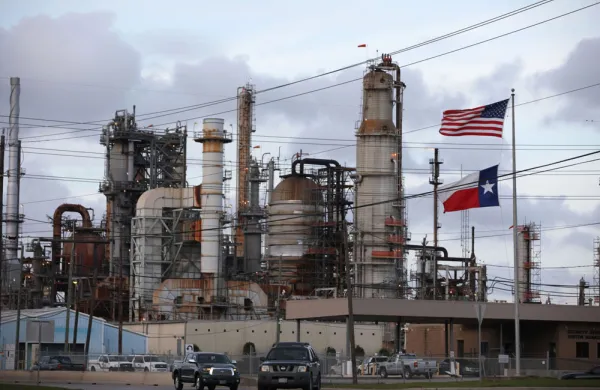
Illustration by Dalbert B. Vilarino
After Dan Rasmussen, founder of Verdad Advisers, pored over the performance of private-equity energy investments, a discrepancy nagged at him: Private funds focused on energy had fared strikingly well compared to small, publicly traded companies in the sector.
Maybe a little too well, to his mind.
It seemed improbable to Rasmussen that most energy funds from vintage years 2012 to 2015 were profitable in 2019. Oil has not recovered from its 2014 plunge — it’s now trading below $30 a barrel, more than 70 percent lower than levels in early 2012 — and energy stocks have sunk over the past six years.
“It’s a mismatch that’s really kind of bizarre,” he recently said by phone. “Either these guys are all geniuses,” or “whatever methodology they’re using to value their portfolio is not comparable to how markets value public companies.”
Private-equity managers typically mark their portfolio performance quarterly, avoiding the daily swings and scrutiny of the public market. Fund valuations can influence a “whole chain of decisions” by end investors, said Rasmussen, from manager selection to spending levels to how much of their portfolios to allocate to an asset class.
Using data from private-markets tracker Cobalt, Rasmussen analyzed the performance of 41 energy funds from vintage years 2012 to 2015, including multiples of investment cost and internal rates of return. (The vintages are determined by when the funds first began investing, he explained, with their marks being as recent as the end of June or September.)
Rasmussen found 83 percent of the funds were marked as profitable — remarkable performance considering the S&P SmallCap 600 Energy Index lost 78 percent from the end of 2012 through September 2019.
“Those two worlds are so far off,” he said.
This year, things have gotten even worse for energy stocks. Investors have fled oil and gas companies on fears that the coronavirus pandemic is sapping energy demand, and that lower crude prices will dent cash flows.
The question, said Rasmussen, is whether private-equity holdings would actually be worth what managers say they are if they tried to sell their energy assets right now. The discrepancy in private-equity energy performance is “egregious,” he said. “What does that say to investors in this asset class — and how they should think about the value of their portfolios?”
But another opaque and niche part of the private-equity world seems to have caught on.
The price they’re willing to pay for stakes in funds focused on energy has declined significantly in secondary trading, according to Michael Dean, a managing director at HarbourVest Partners.
“Most energy secondaries trade at meaningful discounts to net asset value,” he said by phone. By comparison, stakes in private-equity funds across strategies traded at an average 101 percent of NAV in the last half of 2019, according to a survey by Palico, which runs an online marketplace. There, investors can buy and sell interests in funds that lock up capital for years.
“In the energy market, you got underlying companies that today are fairly stuck and trapped in funds,” Dean said. “It’s an unfavorable market to sell the company.”
Even before stock markets plummeted this month, secondary trading reflected trouble in energy, according to Dean, who focuses on real assets, including energy, infrastructure, real estate, and natural resources.
Almost no bids existed for oil and gas portfolios that are below average in quality, he said. Portfolios deemed average to above average tended to sell at “meaningful discounts” of at least 20 percent, said Dean, while “very high-quality” stakes in oil companies sold closer to par.
Many companies are being held around cost or, in some cases, have been written down, according to Dean. He’s seen the majority of energy funds grappling with “middling performance that has not been in line with their expectations.”
Interestingly, the New York-based private-equity firm also stands out because it has a public fund targeting energy — giving investors an opportunity to scrutinize any divergences in performance. And while each fund has its own portfolio, it might be difficult for a private-equity firm to justify any wide divergence in valuations between its own private and public funds targeting the same sector, according to Rasmussen.
On the private side, the $7.7 billion Riverstone Global Energy and Power Fund V had a net IRR loss of 5 percent at the end of September, while the firm’s $4.2 billion Fund VI was marked at a bigger loss of 11 percent, according to the Cobalt data. Fund V, from vintage 2012, was valued around 0.9 times its invested capital, including the unrealized portion of its portfolio. The more recent Fund VI, from vintage 2015, had delivered less of its capital back to investors, and was valued around 0.8 times, the data analyzed by Rasmussen show. Cobalt says on its website that its data are sourced from so-called limited partners, or the investors in the funds it tracks.
Riverstone Energy — the firm’s publicly traded pool targeting oil and gas producers, midstream businesses, and power companies — is down across multiple metrics, also reflecting industry tumult.
A spokesperson for Riverstone declined to comment.
Energy valuations — particularly within exploration and production — continued facing “macro headwinds” in the fourth quarter, Riverstone’s public fund said in the January statement. The firm cited “muted levels” of the forward curve for oil prices, capital markets, and merger activity as challenges.
Fewer assets being sold adds to the “downward pressure” on valuations in the industry, according to Dean. Investors are more likely to question the value that private-equity managers say they could get in a forced sale in a down market, he said, than when portfolios may appear undervalued in rising markets.
“You’re taking a snapshot in time,” he said. Most private-equity firms have “fairly consistent and defendable valuation policies.”
Yet based on the energy fund marks reviewed by Rasmussen, most private-equity firms figured out how to make money during a period when investors were losing money on public equities in the sector. The S&P SmallCap 600 Energy Index lost about 54 percent from the end of 2015 through the end of September. By Rasmussen’s calculations, the equivalent IRR amounts to a 19 percent loss over the same period.
So how to explain the wide divergence in performance between private equity and public equities?
One of the reasons the performance is so striking, according to Rasmussen, is the total value of the fund is high compared to the level of capital it had returned to investors at the time. In other words, the paper marks — which are at least partially tied to the firm’s own judgement — make up a relatively large portion of the fund’s total value, he explained.
Quantum Energy Partners VI was marked at 1.7 times its invested capital, including the unrealized portion, and had returned 0.4 times back to investors, according to the Cobalt data Rasmussen analyzed. A Quantum spokesperson did not return phone calls seeking comment on its performance.
By contrast, Dallas-headquartered Energy Trust Partners has returned the full amount that investors committed to its vintage 2012 fund after selling some of the assets in its portfolio. At the end of last year, the fund was valued at 1.2 times its invested capital, including the unrealized portion, according to James Spann, the firm’s chief compliance officer.
Addressing the assets remaining in its portfolio, Spann said in an email the fund’s “TVPI of 1.2 times is reflective of the softer market valuations today.” TVPI, or total value to paid-in, measures how well a fund has done based on realized returns plus the paper value of remaining assets.
“The fund created several very strong portfolio companies that were able to add significant value and then was able to sell them to strategic energy company buyers for cash in the recent past,” he said. “This cash was then all distributed back to the investors.”
The fund, Energy Trust Partners IV, had an IRR of 11 percent at the end of last year, with Spann saying all the performance marks were net of fees and expenses.
“The swings in the stock market for energy companies have no impact on our fund valuations,” Spann said. “The underlying value of the oil and gas reserves and related acreage is where the value is based.”
Energy Trust’s year-end reserves are valued by independent, third-party petroleum-reservoir engineering firms that provide the same type of service for banks and other long-term lenders, according to Spann. Mergers and acquisitions in the industry also inform fund marks, he said, pointing to a “very large and deep market for buying and selling oil and gas reserves” in the U.S. “Taking the pulse of that M&A market is a bigger factor in the valuation process,” he said. And Energy Trust can be patient about selling.
“While the recent fall in oil and gas prices may crimp the remaining portfolio company’s current revenues, we are in no rush to sell our companies into a soft market,” he said. “When markets are weak, that is when the best new investment opportunities typically arise for the long term.”
Last year, Texas Teachers increased its targeted exposure to private markets — including private equity; real assets; and energy, natural resources, and infrastructure — by 3 percentage points to 35 percent. That’s “one of the highest asset allocations of public plans in the United States,” Auby said, adding that private equity has been the pension’s “top-performing asset class” over the past decade.
Texas Teachers’ private-equity investments returned an annualized 13.6 percent in the three years through September, the same gain as its benchmark, State Street Private Equity Index, according to documents from its investment management committee. The pension’s private-equity gains over five years were 11.2 percent, beating its benchmark by about 60 basis points.
Auby said he sees private-equity firms promoting strong governance on the boards of companies they buy, helping to drive the creation of value over the longer term. Over time, he said, their success as owners has justified the so-called illiquidity premium — the higher yield investors seek by tying up their capital in private-equity funds for years. But he cautioned that identifying “top-quartile managers” is important, as “the median manger may have more difficulty justifying the illiquidity premium.”
Before increasing its private-markets allocation, the pension fund “took a deep look at liquidity in the whole portfolio,” according to Auby. “We reached the conclusion that 35 percent would be a prudent level from a liquidity perspective.”
Texas Teachers’ investments in energy, natural resources, and infrastructure returned 10.1 percent over the three years through the third quarter of 2019, exceeding its benchmark’s 7.5 percent gain, according to the pension’s investment committee documents. Seventy-five percent of the benchmark is linked to the Cambridge Associates Natural Resources Index, with the remaining 25 percent tied to the quarterly, seasonally adjusted Consumer Price Index.
The pension monitors private-equity performance from quarter to quarter and takes a close look at returns when firms are asking investors for money for new funds, according to Auby.
While the pension would prefer daily, mark-to-market prices on its private investments, “we understand that’s not feasible,” he said. “We have to balance that lack of up-to-the-minute marks with the potential for higher return.”
Private equity has long appealed to investors. The industry produced an annualized return of 15.6 percent in the decade through June, according to Preqin, a provider of alternative assets data. That compares with a one-year gain of 16.3 percent at the end of June.
It's not lost on Texas Teachers that infrequent valuations can make private equity seem less volatile than stocks.
“You can’t simply look at the volatility of a smoothed return stream,” said Auby. “You have to proxy that return stream at the equivalent public-markets risk level.”
The pension fund monitors performance with help from Albourne Partners, a provider of portfolio management services to institutional investors such as pensions and endowments. “We have increased our focus on operational due diligence,” said Auby, with Albourne examining the valuation policies and procedures of the funds in which the pension invests.
Auby believes private-equity mangers have incentive to be aligned with Texas Teachers when it comes to accurately marking fund valuations. They’re ultimately compensated based on the sale of companies in their portfolio, he said.
Most firms do formal valuations on a quarterly basis, with their deal teams putting together reports on their investments, according to Timothy Clark, a partner in law firm Goodwin Procter’s private equity group. A valuation committee will weigh a “constellation of factors” before deciding whether an investment should be held at cost, written up, or written down, he said in a phone interview.
For example, an unsolicited bid, significant financial problems, or a big increase in earnings could all prompt a change, Clark said. Before making any adjustments, he said, private-equity firms consider trading levels of comparable businesses, as well as the markets they operate in.
“There is fulsome discussion,” Clark said. “The valuations don’t come out of thin air.”
Other experts in the private-equity industry also say managers do diligent work on valuing their portfolios of companies. Still, beyond the concerns of Rasmussen, red flags may pop up.
Valuations must be done at least annually, with audited financial statements usually going out within 90 to 120 days of year-end, according to Nicholas Tsafos, a partner at EisnerAmper. For Tsafos, a private-equity firm’s original investment thesis is important to consider when reviewing its valuations.
“We expect them to stay with that thesis,” he said by phone, and to provide a solid reason for any change. While an acquisition that transformed a company may well make sense, Tsafos said that struggling to give a reasonable explanation for a change raises red flags.
“If we see jumping around” — from, say, a discount cash flow model to a revenue model, or to one that’s tied to observable public companies — “we start asking a lot of questions,” he said. “If nothing has really changed and they’re just jumping around, that’s a reason for concern.”
Tsafos explained that financial statements may be based on models tied to companies’ revenue; discounted cash flow; or earnings before interest, taxes, depreciation, and amortization. Significant changes to quarterly valuations typically account for important events, he said, such as a bankruptcy, an additional equity investment from a third party, or an acquisition made by a portfolio company.
“There’s a lot of work that goes on behind a valuation,” said Tsafos. “Doing valuations throughout the year is pretty cumbersome.” While fund marks may at times be challenged by investors, he said they understand that the economic conditions at the time of a sale will ultimately dictate fair value.
“That’s why they have a long-term outlook,” Tsafos said.
It’ll be “a fizzle,” he said. “You’re just going to end up disappointed” years down the road.
Instead of constant market feedback on their private-equity portfolios, investors are receiving infrequent marks based in part on the judgment of fund managers. There is some degree of art to that, according to Goodwin’s Clark, who believes fund managers generally seek to do the right thing. Commonfund’s co-head of real assets and sustainability, Ethan Levine, agrees.
“Valuation is an art, not a science,” Levine said by phone.
But it’s that very subjectivity that makes Rasmussen uneasy when he spots big discrepancies. Fund marks should pass “the smell test” within reasonable bounds, he said. Of course, private-equity firms eventually have to sell businesses — which is when the smell test becomes the true test.





